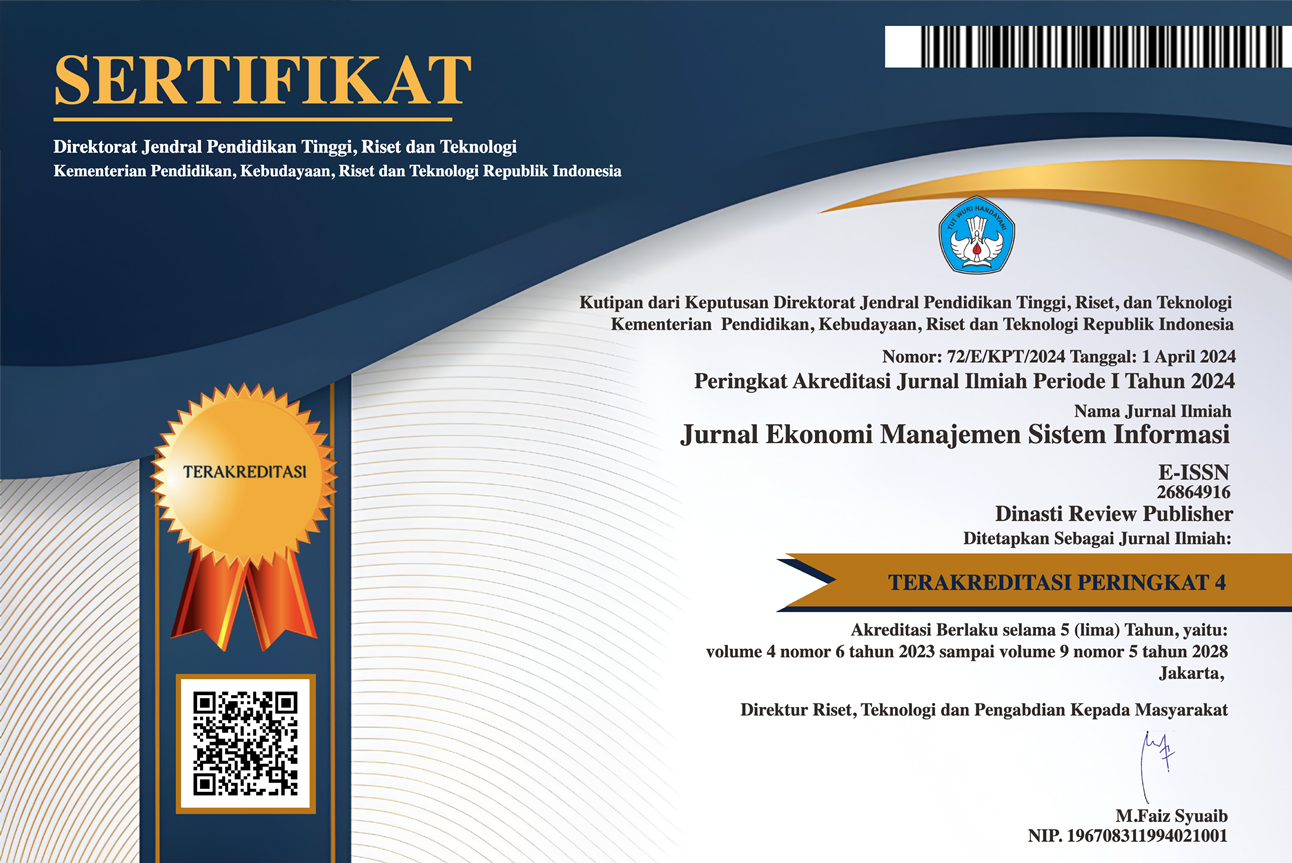Pengaruh ChatBot Terhadap Purchase Decision yang dimediasi oleh Kepercayan Konsumen
DOI:
https://doi.org/10.38035/jemsi.v6i4.4609Keywords:
Chatbot, Kepercayaan Konsumen, Keputusan Pembelian, E-commerceAbstract
Perkembangan E-commerce telah mendorong penggunaan teknologi chatbot sebagai alat komunikasi utama antara pelanggan dan penyedia layanan. Penelitian ini bertujuan untuk menganalisis pengaruh chatbot terhadap Purchase Decision konsumen, dengan Customer Trust sebagai variabel mediasi. Metode penelitian yang digunakan adalah kuantitatif dengan pendekatan Partial Least Squares-Structural Equation Modeling (PLS-SEM). Data dikumpulkan melalui kuesioner daring yang melibatkan 113 responden yang telah bertransaksi di Shopee Mall. Hasil penelitian menunjukkan bahwa chatbot memiliki pengaruh signifikan terhadap Cunsomer Trust (t-statistic 23.949, p > 1.96) dan Purchase Decision (t-statistic 2.224, p > 1.96). Selain itu, kepercayaan konsumen berperan sebagai mediator yang memperkuat hubungan antara chatbot dan keputusan pembelian (t-statistic 7.147, p > 1.96). Koefisien determinasi (R²) menunjukkan bahwa chatbot dan kepercayaan konsumen mampu menjelaskan 81,5% variabilitas keputusan pembelian. Implikasi penelitian ini menyoroti pentingnya pengembangan chatbot yang responsif dan akurat untuk meningkatkan kepercayaan konsumen serta mendorong keputusan pembelian.
References
Ardiansyach, H. T., Widjajanti, K., & Rusdianti, E. (2022). Pengaruh penerapan standar operasional prosedur dan GeoKKP terhadap kinerja pegawai dengan motivasi kerja sebagai variabel moderator. Jurnal Riset Ekonomi Dan Bisnis, 15(2), 76–94. https://doi.org/10.26623/JREB.V15I2.4163
Belanche, D., Casal´o, L.V., Schepers, J., Flavi´an, C., 2021. Examining the effects of robots’ physical appearance, warmth, and competence in frontline services: the Humanness-Value-Loyalty model. Psychol. Market. 38 (12), 2357–2376
Benitez, J., Henseler, J., Castillo, A., & Schuberth, F. (2020). How to perform and report an impactful analysis using partial least squares: Guidelines for confirmatory and explanatory IS research. Information & Management, 57(2), 103168. https://doi.org/10.1016/j.im.2019.05.003
Caldarini, G., Jaf, S., McGarry, K., 2022. A literature survey of recent advances in chatbots. Information 13 (1), 41. Information 13 (1)
Chia-Ying Li1, Kuo-Wei Lee2 (2023). It is not merely a chat: Transforming chatbot affordances into dual identification and loyalty, Elsevier. https://doi.org/10.1016/j.jretconser.2023.103447
Chung, M., Ko, E., Joung, H., & Kim, S. J. (2018). Chatbot e-service and customer satisfaction regarding luxury brands. Journal of Business Research, 117, 587–595. https://doi.org/10.1016/j.jbusres.2018.10.004
Crolic, C., Thomaz, F., Hadi, R., Stephen, A.T., 2022. Blame the bot: anthropomorphism and anger in customer–chatbot interactions. J. Market. 86 (1), 132–148
Dai, Y., Huang, Y.-H. C., Jia, W., & Cai, Q. (2022). The paradoxical effects of institutional trust on risk perception and risk management in the COVID-19 pandemic: Evidence from three societies. Journal of Risk Research, 25(11–12), 1337–1355. https://doi. org/10.1080/13669877.2022.2108122
Diederich, S., Lembcke, T.-B., Brendel, A.B., Kolbe, L.M., 2021. Understanding the Impact that Response Failure Has on How Users Perceive Anthropomorphic Conversational Service Agents: Insights from an Online Experiment. THCI, pp. 82–103
Faqih, K. M. (2022). Internet shopping in the COVID-19 era: Investigating the role of perceived risk, anxiety, gender, culture, and trust in the consumers’ purchasing behavior from a developing country context. Technology in Society, 70, Article 101992. https://doi.org/10.1016/j.techsoc.2022.101992
Gefen, D., Karahanna, E., & Straub, D. W. (2003). Trust and TAM in online shopping: An integrated model. MIS Quarterly, 27(1), 51–90. https://doi.org/10.2307/30036519
Gkinko, L., & Elbanna, A. R. (2022). AI chatbots sociotechnical research: An overview and future directions. International Workshop on Socio-Technical Perspective in IS Development. https://www.semanticscholar.org/paper/AI- chatbots-sociotechnical-research%3A-An-overviewGkinko Elbanna/2895234e5bf98628a750eeb6f4db80ceeacca22d
Hair, J. F., Hult, G. T. M., Ringle, C. M., & Sarstedt, M. (2022).
A Primer on Partial Least Squares Structural Equation Modeling (PLS-SEM) (3rd ed.). SAGE Publications.
Henseler, J., Ringle, C. M., & Sarstedt, M. (2015). A new criterion for assessing discriminant validity in variance-based structural equation modeling. Journal of the Academy of Marketing Science, 43(1), 115–135.
Hoyer, W.D., Kroschke, M., Schmitt, B., Kraume, K., Shankar, V., 2020. Transforming the customer experience through new technologies. J. Interact. Market. 51, 57–71.
Huang, Y.-S., Dootson, P., 2022. Chatbots and service failure: when does it lead to customer aggression. J. Retailing Consum. Serv. 68, 103044
Jadil, Y., Rana, N. P., & Dwivedi, Y. K. (2022). Understanding the drivers of online trust and intention to buy on a website: An emerging market perspective. International Journal of Information Management Data Insights, 2(1), 100065. https://doi.org/10.1016/j.jjimei.2022.100065
Kementrian Perdaganagan (2025), Perdagangan Digital (E-Commerce) Indonesia Periode 2023
Khatri, Lalu Rahadian, Indonesia, C., & Razak, N. (2022). Tiga Kota Ini Alami Peningkatan Tren Belanja Daring. CNBC Indonesia. https://www.cnbcindonesia.com/tech/20220117110524-37-307870/tiga- kota-ini-alami-peningkatan-tren-belanja-daring
Kim, D. J., Ferrin, D. L., & Rao, H. R. (2008). A trust-based consumer decision- making model in electronic commerce: The role of trust, perceived risk, and their antecedents. Decision Support Systems, 44(2), 544–564. https://doi.org/10.1016/j.dss.2007.07.001
Kotler, P., & Keller, K. L. (2016). A framework for marketing management (Sixth edition). Pearson
Kreps, S., George, J., Lushenko, P., & Rao, A. (2023). Exploring the artificial intelligence “trust paradox”: Evidence from a survey experiment in the United States. PLoS One, 18(7) , Article e0288109. https://doi.org/10.1371/journal.pone.0288109
Lingfeng Dong1, Zhongsheng Hua2, Liqiang Huang3, Ting Ji4, Fengxin Jiang5, Guangzhu Tan6, Jie Zhang7. (2024). The impacts of live chat on service–product purchase: Evidence from a large online outsourcing platform” Elsevier. https://doi.org/10.1016/j.im.2024.103931
Low, T. A., White, E. D., Koschnick, C. M., & Elshaw, J. J. (2022). Sum-Based Scoring for Dichotomous and Likert-scale Questions
Luo, X., Tong, S., Fang, Z., Qu, Z., 2019. Frontiers: machines vs. humans: the impact of artificial intelligence chatbot disclosure on customer purchases. Mark. Sci. 38 (6), 937–947.
Pestek, A., Resi´c, E., & No?zica, M. (2011). Model of trust in e-transactions. Economic Research-Ekonomska Istra?zivanja, 24(3), 131–146. https://doi.org/10.1080/ 1331677X.2011.11517472
Rajaobelina, L., Prom Tep, S., Arcand, M., Ricard, L., 2021. Creepiness: its antecedents and impact on loyalty when interacting with a chatbot. Psychol. Market. 38 (12), 2339–2356.
Schwede, M., Meyer, N., & Hammerschmidt, M. (2023). Can Chatbots Be Persuasive? How to Boost the Effectiveness of Chatbot Recommendations for Increasing Purchase Intention. Proceedings of the 56th Hawaii International Conference on System Sciences.
Sheehan, B., Jin, H.S., Gottlieb, U., 2020. Customer service chatbots: anthropomorphism and adoption. J. Bus. Res. 115, 14–24.
Sindhu, P., & Bharti, K. (2023). Influence of chatbots on purchase intention in social commerce. Behaviour & Information Technology, 1–22. https://doi.org/10.1080/0144929X.2022.2163188
Slovin, E. (1960). Sampling Techniques for Surveys and Research.
Spence, P. R., Edwards, A., Edwards, C., & Jin, X. (2019). ‘The bot predicted rain, grab an umbrella’: Few perceived differences in communication quality of a weather Twitterbot versus professional and amateur meteorologists. Behaviour & Information Technology, 38(1), 101–109. https://doi.org/10.1080/0144929X.2018.1514425
Sugiyono, Prof. Dr. (2018). Metode Penelitian Kuantitatif, Kualitatif, dan R&D. Bandung: Alfabeta
Wang, J., Shahzad, F., Ahmad, Z., Abdullah, M., & Hassan, N. M. (2022). Trust and Consumers’ Purchase Intention in a Social Commerce Platform: A Meta-Analytic Approach. SAGE Open. https://doi.org/10.1177/2158244022109126
Wicaksono, B. B. (2022). Pengaruh Tenaga Kerja dan Belanja Pemerintah Daerah terhadap Perkembangan Sektor Pertanian di Kabupaten Cianjur Provinsi Jawa Barat. Buletin Poltanesa, 23(1). https://garuda.kemdikbud.go.id/ documents/detail/2814044
Yen, C., & Chiang, M.-C. (2021). Trust me, if you can: A study on the factors that influence consumers’ purchase intention triggered by chatbots based on brain image evidence and self-reported assessments. Behaviour & Information Technology, 40(11), 1177–1194.https://doi.org/10.1080/0144929X.2020.1743362
Zikria, Y. B., Ali, R., Afzal, M. K., & Kim, S. W. (2021). Next-Generation Internet of Things (IoT): Opportunities, Challenges, and Solutions. Sensors, 21(4), 1174. https://doi.org/10.3390/s21041174
Downloads
Published
How to Cite
Issue
Section
License
Copyright (c) 2025 Achmad Syauqi Ilal Jinan, Wahidatur Rosdiyah, Reni Rupianti

This work is licensed under a Creative Commons Attribution 4.0 International License.
Hak cipta :
Penulis yang mempublikasikan manuskripnya di jurnal ini menyetujui ketentuan berikut:
- Hak cipta pada setiap artikel adalah milik penulis.
- Penulis mengakui bahwa Jurnal Ekonomi Manajemen Sistem Informasi (JEMSI) berhak menjadi yang pertama menerbitkan dengan lisensi Creative Commons Attribution 4.0 International (Attribution 4.0 International CC BY 4.0) .
- Penulis dapat mengirimkan artikel secara terpisah, mengatur distribusi non-eksklusif manuskrip yang telah diterbitkan dalam jurnal ini ke versi lain (misalnya, dikirim ke repositori institusi penulis, publikasi ke dalam buku, dll.), dengan mengakui bahwa manuskrip telah diterbitkan pertama kali di Jurnal Ekonomi Manajemen Sistem Informasi (JEMSI).











































































